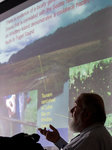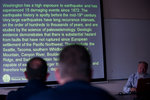

In a dimmed room in front of a slideshow presentation with an audience primarily made up of Lewis County fire chiefs, a geologist said a fault line between Centralia and Chehalis that has been researched very little crosses Interstate 5.
It is actually unknown whether or not the Doty Fault is active.
“Plans are underway to study this more intensively, and if it turns out that this is active, it’s a fault that would be capable of an earthquake between 6½ and 7 (magnitude),” said Timothy J. Walsh, chief geologist with the Washington State Department of Natural Resources.
Walsh said part of the reason to study the fault more is to learn how it would affect the proposed water retention dam on the Chehalis River near Pe Ell.
“Whether this is active would be very important in … what the design of that should be,” he said.
Scientists have recently started using LiDAR technology, which measures distance with a laser by analyzes the light reflected, to study faults and have not done so yet for the Doty Fault.
More research has been completed on the active Saint Helens Seismic Zone, which is partially located in Lewis County and has a capacity for a magnitude-7.0 earthquake.
In the more populated West Lewis County, a Saint Helens earthquake is estimated to cause little to no damage.
He said Lewis County should expect to see moderate damage from an earthquake of the entirety of the Cascadia subduction zone.
In fact, he said, if an earthquake of the entire Cascadia subduction zone were to occur, Washington wouldn’t be as affected as the two states south of it. He also said that the Pacific Northwest isn’t overdue for an earthquake of the entire zone.
The timeline for the potential magnitude-9.0 earthquake in the July 20 New Yorker article, “The Really Big One,” was misleading, he said.
While the 1700 Cascadia earthquake referred to in the article was a rupture of the entire subduction zone, individual sections of the zone are also estimated to have experienced quakes in history.
The article says that the zone is 315 years into a 243-year cycle of its earthquake recurrence.
Of the 41 total Cascadia events in the past 10,000 years, about half are estimated to have only affected smaller areas in the segmented zone, Walsh said.
He said that the nearly 250-year cycle applies to both separate smaller earthquakes in the Cascadia Subduction Zone as well as earthquakes of the entire zone.
An earthquake of the entirety of Cascadia has a recurrence of 500 to 550 years that would affect northern California to British Columbia.
Scientists study recurrence by looking at landslides from the edge of the continental shelf that flow into submarine canyons, depositing in the Cascadia Basin.
Walsh said researchers are beginning to do models of the 1700 earthquake to better understand the effects it had.